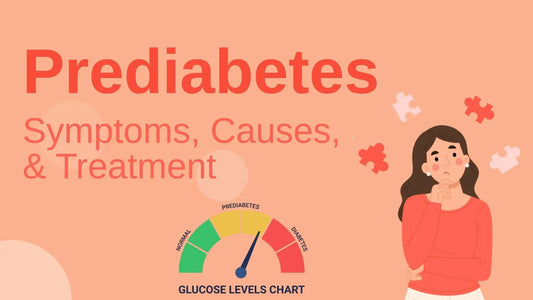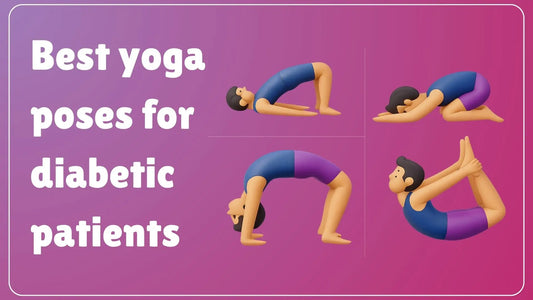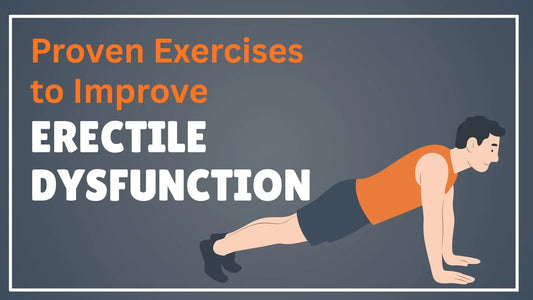
Prediabetes: Symptoms, Causes, Treatment & More
Prediabetes means you are close to type 2 diabetes. It sounds scary, but you don't need to panic. It does not mean you have diabetes. It means you are at risk, and if you take action now so you can prevent yourself from getting diabetic.
Here we will understand prediabetes, its symptoms, causes, risk factors, and prevention. So let’s start:
What is prediabetes?
Prediabetes is a warning sign. It means your blood sugar (glucose) levels are higher than normal but not high enough to be diagnosed as type 2 diabetes.
Think of it like a yellow traffic light. It’s a signal to slow down, reassess, and take control before things get worse.
Symptoms of Prediabetes
Often, prediabetes has no clear symptoms. Many people don’t know they have prediabetes until it progresses to type 2 diabetes.
Some people found themselves with acanthosis nigricans (dark patches on the neck or armpits) condition associated with prediabetic symptoms.
Therefore, you should watch out for a few signs:
-
Constant fatigue or low energy
-
Increased hunger or cravings
-
Frequent urination (usually at night)
-
Blurred vision
-
Slow-healing wounds and cuts
These are also symptoms of type 2 diabetes. So it is necessary to check your blood sugar level before it's too late.
Causes of Prediabetes
The cause of prediabetes is the same as that of type 2 diabetes, which means Insulin resistance and metabolic disturbance are the main causes.
Insulin resistance: Our body makes insulin to move sugar from the blood into cells that convert it into energy. In prediabetes, your cells don’t respond well to insulin.
metabolic disturbance: When the body’s ability to convert food into energy is disturbed, then this is called metabolic syndrome and diabetes.
Blood Sugar Range for Prediabetes:
-
Normal: Fasting blood sugar < 100 mg/dL
-
Prediabetes: Fasting blood sugar 100–125 mg/dL
-
Diabetes: Fasting blood sugar ≥ 126 mg/dL
If you’ve had an HbA1c test, a result between 5.7% and 6.4% also falls in the prediabetes range.
Risk Factors of Prediabetes
There is not only one single reason for prediabetes; it has various causes. A study indicates some parameters, such as age, sex, BMI, blood pressure, diabetes family history, and lifestyle, as risk factors for prediabetes.
Also, the risk factors might be different between males and females. Some possible risk factors based on research papers are mentioned below:
-
Being Overweight or Obese: Excess body fat, especially around the belly, makes your cells more insulin-resistant. This leads to higher blood sugar levels over time.
-
Lack of Physical Activity: Regular exercise helps your body use insulin better. A sedentary lifestyle increases the risk of insulin resistance and weight gain.
-
Unhealthy Diet: Consuming too much sugar, refined carbs, processed foods, and sugary drinks can lead to weight gain and high blood sugar levels.
-
Family History: If your parents or siblings have type 2 diabetes, your risk increases due to shared genes and lifestyle habits.
-
Age: The risk of prediabetes increases after age 45. However, more young adults and even teens are being diagnosed due to poor diet and inactivity.
-
Hormonal Balance: Conditions like polycystic ovary syndrome (PCOS) affect hormone levels and can make it harder for the body to use insulin properly, raising diabetes risk.
-
Stress: Chronic stress triggers the release of stress hormones like cortisol, which can raise blood sugar levels. Over time, this constant spike in blood sugar may lead to insulin resistance and increase the risk of prediabetes or diabetes.
-
Alcohol & Tobacco: Use: Excessive alcohol and tobacco use can affect how your liver regulates blood sugar. It can also lead to weight gain and liver damage, both of which increase diabetes risk.
Diagnosis and Tests for Prediabetes
Prediabetes is often silent that’s why testing is crucial. Doctors typically use the following blood tests to diagnose prediabetes:
-
Fasting Blood Sugar Test (FBS): Measures your blood sugar after fasting for at least 8 hours. A result between 100–125 mg/dL suggests prediabetes.
-
HbA1c (Glycated Hemoglobin Test): Shows your average blood sugar level over the past 2–3 months. A reading between 5.7% and 6.4% indicates prediabetes.
-
Oral Glucose Tolerance Test (OGTT): Involves checking your blood sugar before and 2 hours after drinking a sugary drink. A level between 140–199 mg/dL after 2 hours is considered prediabetes.
These tests are quick and simple and help identify prediabetes early—before it turns into type 2 diabetes.
Prevention of Prediabetes
Yes, prediabetes can often be prevented! The same strategies used to reverse it are also great for prevention. Here’s how you can stay ahead:
-
Be Physically Active: Aim for at least 30 minutes of moderate exercise (like walking, cycling, or dancing) 5 days a week.
-
Maintain a Healthy Weight: Losing even 5–7% of your body weight if you're overweight can drastically reduce your risk.
-
Eat a Nutritious Diet: Focus on whole grains, vegetables, lean proteins, healthy fats, and limit added sugars and refined carbs.
-
Avoid Smoking: Smoking can worsen insulin resistance. Quitting helps your overall health and blood sugar control.
While some people may still develop prediabetes due to strong genetic factors, these lifestyle changes can significantly lower your risk.
Treatment of Prediabetes
The most effective treatment for prediabetes is making sustainable lifestyle changes. These healthy habits not only lower your blood sugar but may also reverse prediabetes entirely.
Here’s how:
-
Lose Excess Weight: Studies show that losing just 7% of your body weight can cut your risk of type 2 diabetes by up to 58%.
-
Exercise Regularly: Moderate-intensity activities, like brisk walking, improve how your body uses insulin and lower blood sugar levels. Aim for 150 minutes a week.
-
Make Better Food Choices: Cut back on sugary foods and drinks, eat more vegetables and fiber-rich foods, and choose complex carbs over simple ones.
-
Lower Other Risk Factors: Manage high blood pressure, high cholesterol, and sleep issues. Reduce stress, quit smoking, and consider working with a dietitian or joining a support group.
Conclusion
Prediabetes is a second chance to regain your health. It signals you to slow down and reevaluate. It's not a diagnosis of diabetes, but rather a valuable chance to take control of your health before things progress.
The encouraging part? With the rightsteps you can reverse prediabetes and prevent type 2 diabetes altogether. Staying informed and understanding your personal risk factors are essential tools in your wellness journey. Take proactive steps by consulting your doctor today.

Dr. Pooja Verma
Dr. Pooja Verma is a sincere General Ayurvedic Physician who holds a BAMS degree with an interest in healing people holistically. She makes tailor-made treatment plans for a patient based on the blend of Ayurveda and modern science. She specializes in the treatment of diabetes, joint pains, arthritis, piles, and age-related mobility issues.



